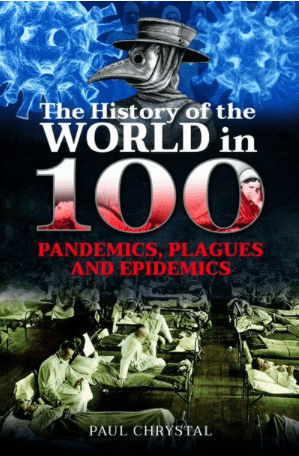Arpan Banerjee
Solihull, United Kingdom
 |
|
Cover: The History of the World in 100 pandemics, plagues and epidemics. |
The publication of this book could not have been better timed. The book sets out to show how pandemics, epidemics, and infectious diseases have shaped human history over the last 5,000 years. Its contents help us place the current COVID-19 epidemic in its rightful historical context. Famine, war, and pestilence have long been the scourge of mankind.
Twenty years ago, using advanced DNA sequencing techniques, researchers from France, Denmark, and Sweden discovered evidence of plague DNA in bodies from cemeteries in Sweden dating from the late Neolithic age. This may well have been the first pandemic, and explains the disappearance of some of the early Neolithic civilizations which extended from the Carpathian regions to the Ukraine. Similarly, early Neolithic civilizations in the region of Turkey were also affected by a plague: malaria and dysentery pandemics. They were wiped out around 7000BC.
The first recorded epidemic was the great pestilence that occurred in Egypt. Even then humans, with their ingenuity, realized the importance of controlling the spread of disease and their kings recommended that subjects not share drinking cups. As early as 2300 BC the Babylonians understood that rabies could be spread by the bite of a dog. In these cases, owners of the dog were severely fined. In the Bible there are many references to the infectious plague and its consequences.
Around 400 BC, the ancient Greeks, especially Hippocrates, were aware of infectious diseases such as plague, typhus, smallpox, tuberculosis, and malaria. Also at this time influenza, a major killer, spread through the dense populations of central Asia, Mesopotamia, and southern Asia.
The best-known plague of ancient times is of course the plague of Athens in 430 BC which was described by Thucydides the historian and led to the fall of Pericles and the great city state he led. The plague of Justinian from A.D. 541 to 542 is often considered to be the first pandemic and it seriously destabilized the Byzantine Empire.
In AD 664 the plague reached British shores. In the Middle Ages plague or the Black Death spread through Europe wiping out great proportions of the population wreaking havoc on and off for over a century. Plague also occurred throughout the seventeenth century. This period in history has been well chronicled by writers such as Daniel Defoe in the UK.
Epidemics elsewhere, for example the United States’ struggle with yellow fever, typhoid, cholera, and smallpox epidemics are covered in the text. It also covers the major worldwide smallpox and influenza epidemics. There are chapters on TB and leprosy. The twentieth century polio, cholera, and influenza pandemics are discussed as is the HIV pandemic of the 1980s. We are brought up to date with the twenty first century pandemics such as SARS, MERS, Zika, and Ebola outbreaks and of course COVID-19.
This timely book is an excellent historical chronicle of the pandemics and epidemics that have plagued mankind. The author, who has a background in medical publishing and education and a keen interest in history, has produced a highly readable account and his extensive research has placed these diseases in their historical contexts. The references at the end of each chapter provide further reading material for interested readers and there is a comprehensive index. The book will appeal to medical and healthcare professions as well as to lay readers worldwide. All can reflect on Louis Pasteur’s quote, which is featured at the start of the book: “Gentlemen, it is the microbes which will have the last word.”
The History of the World in 100 pandemics, plagues and epidemics by Paul Chrystal.
Pen and Sword Books Ltd, UK, 2021.
ISBN 9781399005425
ARPAN K. BANERJEE, MBBS (LOND), FRCP, FRCR, FBIR, qualified in medicine at St. Thomas’s Hospital Medical School, London. He was a consultant radiologist in Birmingham from 1995-2019. He served on the scientific committee of the Royal College of Radiologists 2012-2016. He was Chairman of the British Society for the History of Radiology from 2012-2017. He is Chairman of ISHRAD and adviser to radiopaedia. He is the author/co-author of numerous papers and articles on a variety of clinical medical, radiological, and medical historical topics and seven books including Classic Papers in Modern Diagnostic Radiology 2005 and “The History of Radiology” OUP 2013.

Leave a Reply